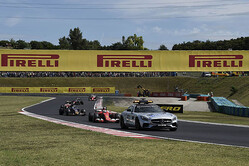


29/02/2016
FEATURE BY GUEST AUTHORS
 In Formula One, if something can be simple, it usually isn't.
In Formula One, if something can be simple, it usually isn't.
It's not a stretch to imagine the above phrase dancing off the tongue of a particularly confused Murray Walker, trying to explain how Damon Hill went from fifth, to fourth, to seventh. While there's no YouTube evidence to support that the great Muzza ever said this, if he had, he would have been AB-SO-LUTELY right.
"And now, excuse me while I interrupt myself"
Today's commentators have it pretty easy. Since modern F1 races are entirely predictable, the presenters rarely make prophecies that immediately turn out to be wrong.
Barring an unlikely mechanical failure, the winner is often determined after the first corner of the first lap. Sure, there's a bit of wheel-banging in the midfield every now and again, but what fans really want is legitimate fights for the lead, throughout each stage of a Grand Prix.
To improve the show, F1 stakeholders continue to debate a variety of complex and expensive solutions. "Return to V8s," some say. "Run three-car teams," others maintain. Bernie Ecclestone suggested a number of strange fixes - from sprinklers, to shortcuts, to gold medals and beyond. Yet, F1's kingpins continue to overlook a simple solution that would guarantee excitement.
"The safety car has been deployed"
To a Formula One fan, there isn't a more exhilarating statement.
A safety car means instant action. The field bunches together. Teams scramble to make pit stops. The result, when the green flag waves, is pack racing at its finest.
The trouble is, with everlasting engines and asphalt run-offs, Bernd Maylander rarely has a reason to don his driving gloves these days. In 2015, the safety car was deployed just 14 times in 19 races. Eight events featured no safety car at all.
It's time for a steadfast rule that mandates a safety car every time marshals or recovery vehicles enter the circuit - like most forms of racing in the United States. To use NASCAR lingo, not only would this rule increase "Caution periods," and in doing so produce closer and more unpredictable racing, but it would also improve safety.
All too often, replays show daring course workers - like the "very brave Russian" who was nearly clouted by Sebastian Vettel in Sochi - darting onto the track to retrieve debris before the pack comes around. It's an unacceptable risk.
{youtube HZXFSDVPl_U 560x315}
"Unless I am very much mistaken…"
The argument against increased safety car use is that it's too artificial. It robs the leaders of their well-earned advantage and is a blight on F1's sporting integrity.
But under the current regulations, confusion reigns whenever the safety car appears. Sometimes Charlie Whiting waits a lap or two before triggering the SC signal. Sometimes he activates the virtual safety car first, and then changes his mind and sends out a real-life Mercedes-Benz AMG GT-S after all. Meanwhile, team strategists take their best guess as to a course of action. Luck plays a major role in the outcome. It's a subjective call with little consistency.
Standardizing the rule would allow every team to prepare for inevitable SC periods when crafting their race strategies. Frontrunners may choose to save fuel and tires early in a race, instead of building large leads over the rest of the pack. Midfield teams may take high-risk/high-reward gambles, foregoing tire stops during late-race SC periods to jump to the front of the queue. The teams and drivers that react best to these situations would reap, and earn, the rewards.
"And it's go, go, go!"
To make the concept most effective, the restart procedure should be amended.
It's wrong to allow the leader to control the pace of the restart. It's simply too easy for the "absolutely unique lead car" to get the jump on "the one behind, which is identical." Instead, restarts should be handled like IndyCar (maybe the Americans are on to something here?), where the leader must maintain a set speed until the pack enters the start straight. Only when the green flag waves can the leader accelerate to racing speeds.
"There's nothing wrong with the car except that it's on fire"
Mandatory safety cars wouldn't solve all of F1's troubles, but would improve the show and reduce the likelihood of one driver racing away unchallenged. And, if there was more on-track action, more wheel-to-wheel battles for the lead, the din of the engines and the dominance of one team would no longer dictate the headlines.
It's a simple solution. It doesn't require a single change to the cars or necessitate that teams spend more money. It could be adopted tomorrow without much more than a small conversation in the pre-race drivers' briefing. In no time, commentators around the globe would echo Murray whenever the SC signal appeared: "Ding, dong! Are we going to see a race now!"